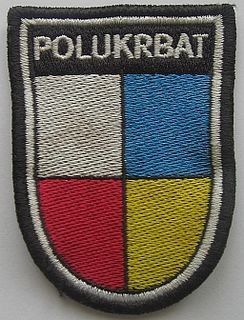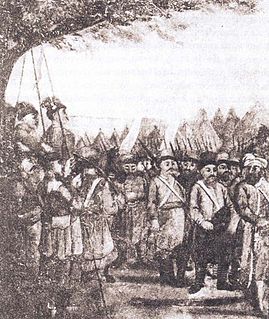 W
WThe Armed Forces of Ukraine had a large number of Guards units. On 22 August 2016, as part of a reform of the insignia of the Armed Forces, the Guards titles were removed from the names of the units. The page lists all former Ukrainian guards units.
 W
WThe 92nd Training Centre was a formation of the Ukrainian Ground Forces, that drew most of its history from the 92nd Guards Rifle Division, that became the 92nd Guards Training Motor Rifle Division in 1965.
 W
WThe 169th Training Centre is a division-sized training formation of the Ukrainian Ground Forces. The Training Centre's main task is to prepare young professionals and personnel under contract to the Army Forces of Ukraine.
 W
WFree Cossacks were Ukrainian Cossacks that were organized as volunteer militia units in the spring of 1917 in the Ukrainian People's Republic. The Free Cossacks are seen as precursors of the modern Ukrainian national law enforcement organizations such as the National Guard of Ukraine or the Internal Troops of Ukraine.
 W
WGuards units are elite units and formations in the armed forces of the former Soviet Union and currently in the armed forces of Belarus and Russia. These units were awarded Guards status after distinguishing themselves in service, and are considered to have elite status. The Guards designation originated during the Great Patriotic War of 1941–45, its name coming from the Russian Empire Imperial Guard.
 W
WThe Kyiv Presidential Honor Guard Battalion is a guard of honour unit of the Armed Forces of Ukraine. It is a part of the Hetman Bohdan Khmelnytsky Independent Presidential Guard Regiment.
 W
WThe Lugansk Higher Military Aviation School of Navigators was a flying training school of the Soviet Air Forces and later the Ukrainian Air Force. Established in 1966 in Voroshilovgrad (Lugansk), the school trained navigators until its closure in 1997.
 W
WMultinational Engineer Battalion Tisa is an engineering unit intended to quickly respond to flooding and other natural disasters in the Carpathian Region. Initial idea for creation of such unit was voiced by Ukraine in December 1998. Battalion was created on November 15, 2002 after Heads of General Staff of Hungarian, Romanian, Slovak and Ukrainian Armed Forces signed the Technical Arrangement on Implementation of Intergovernmental Agreement on Multinational Engineer Battalion Tisa in Budapest. The name comes from river Tisza.
 W
WOperational Command East is a formation of the Ukrainian Ground Forces in eastern Ukraine. Its headquarters is currently located in Dnipro.
 W
WOperational Command North is a command of the Ukrainian Ground Forces in northern Ukraine. It was formed in 2013 from the Western Operational Command and Territorial Directorate North by reforming the 13th Army Corps.
 W
WThe Operational Command South is a formation of the Ukrainian Ground Forces in the southern part of Ukraine, which was formed in January 1998 as the Southern Operation Command on the basis of the Odessa Military District and headquartered in Odessa.
 W
WOperational Command West is a formation of the Ukrainian Ground Forces in western Ukraine. Its headquarters is located in Rivne.
 W
WPolish–Ukrainian Peace Force Battalion (POLUKRBAT) or Ukrainian-Polish Peace Force Battalion (UKRPOLBAT) is a Polish-Ukrainian peacekeeping battalion, formed in the late 1990s expressly "for participation in international peace-keeping and humanitarian operations under the auspices of international organizations".
 W
WRegistered Cossacks comprised special Cossack units of the Polish–Lithuanian Commonwealth army in the 16th and 17th centuries.
 W
WSerdyuk were mercenary infantry units kept by the Hetman's Zaporizhzhya Army from the second half of the 17th century through the first quarter of the 18th century and formed the Hetman's guard. Serdyuk recruited mainly from the Ukrainian population and the Kozaks of Cossack Hetmanate and Zaporizhian Sich. The average Serdyuk regiment consisted of 400-500 soldiers. They served at the border and inside the country, and guarded the Hetman's residence. By decree of the Russian Tsar on July 14, 1726, the convivial serdyuk's units were disbanded.
 W
WThe Sich Riflemen Halych-Bukovyna Kurin were one of the first regular military units of the Army of the Ukrainian People's Republic. The unit operated from 1917 to 1919 and was formed from Ukrainian soldiers of the Austro-Hungarian army, local population and former commanders of the Ukrainian Sich Riflemen in Austria-Hungary.
 W
WThe Ukrainian Air Assault Forces, abbreviated DShV, are a branch of the Armed Forces of Ukraine. The air assault forces field high-readiness ground units without air-assets. The air assault forces are in constant combat readiness and are the high mobility branch of the armed forces. They are considered the elite of Ukraine's armed forces.
 W
WThe Ukrainian Naval Infantry Corps is part of coastal defense troops of the Ukrainian Navy. It is used as a component part of amphibious, airborne and amphibious-airborne operations, alone or in coordination with formations and units of the Army in order to capture parts of the seashore, islands, ports, fleet bases, coast airfields and other coast objects from the enemy. It can also be used to defend naval bases, vital shoreline areas, separate islands and coast objects, and security of hostile areas.
 W
WThe Ukrainian People's Army, also known as the Ukrainian National Army (UNA) or simply as Petliurovtsi was the army of the Ukrainian People's Republic (1917–1921). They were often quickly reorganized units of the former Imperial Russian Army or newly formed volunteer detachments that later joined the national armed forces. The army lacked a certain degree of uniformity, adequate leadership to keep discipline and morale. Unlike the Ukrainian Galician Army, the Ukrainian People's Army did not manage to evolve a solid organizational structure, and consisted mostly of volunteer units, not regulars.
 W
WThe Air Fleet of the UPR was the air force of the Ukrainian People's Republic in 1917–1921.
 W
WLegion of Ukrainian Sich Riflemen was a Ukrainian unit within the Austro-Hungarian Army during the First World War.